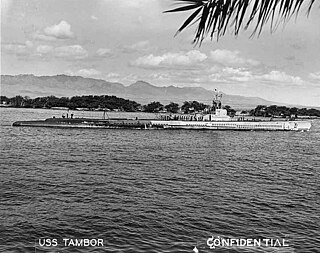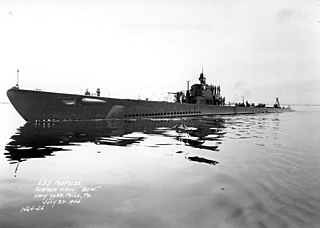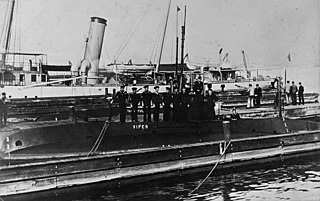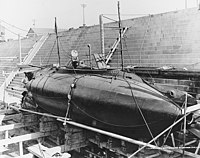
Type XXI submarines were a class of German diesel–electric Elektroboot submarines designed during the Second World War. One hundred and eighteen were completed, with four being combat-ready. During the war only two were put into active service and went on patrols, but these were not used in combat.

USS Holland (SS-1) was the United States Navy's first modern commissioned submarine, although not the first military submarine of the United States, which was the 1775 submersible Turtle. The boat was originally laid down as Holland VI at the Crescent Shipyard of Elizabeth, New Jersey for John Philip Holland's Holland Torpedo Boat Company, and launched on 17 May 1897. She was acquired by the USN on 11 April 1900 and commissioned on 12 October 1900, Lieutenant H. H. Caldwell commanding.

The Gato class of submarines were built for the United States Navy and launched in 1941–1943. Named after the lead ship of the class, USS Gato, they were the first mass-production U.S. submarine class of World War II.

The Greater Underwater Propulsion Power Program (GUPPY) was initiated by the United States Navy after World War II to improve the submerged speed, maneuverability, and endurance of its submarines. (The "Y" in the acronym was added for pronounceability.)

The Balao class was a design of United States Navy submarine used during World War II, and with 120 boats completed, the largest class of submarines in the United States Navy. An improvement on the earlier Gato class, the boats had slight internal differences. The most significant improvement was the use of thicker, higher yield strength steel in the pressure hull skins and frames, which increased their test depth to 400 feet (120 m). Tang actually achieved a depth of 612 ft (187 m) during a test dive, and exceeded that test depth when taking on water in the forward torpedo room while evading a destroyer.

The Tambor-class submarine was a United States Navy submarine design, used primarily during World War II. They were the USN's first fully successful fleet submarine, and began the war close to the fighting. Six of the class were in Hawaiian waters or the Central Pacific on 7 December 1941, with Tautog at Pearl Harbor during the attack. They went on to see hard service; seven of the twelve boats in the class were sunk before the survivors were withdrawn from front-line service in early 1945; this was the highest percentage lost of any US submarine class. Tautog was credited with sinking 26 ships, the largest number of ships sunk by a US submarine in World War II. The Tambors attained the top speed of 21 knots (39 km/h) and range of 11,000 nautical miles (20,000 km) of the preceding Sargo class, and improvements included six bow torpedo tubes, a more reliable full diesel-electric propulsion plant, and improved combat efficiency with key personnel and equipment relocated to the conning tower. In some references, the Tambors are called the "T Class", and SS-206 through SS-211 are sometimes called the "Gar class".

USS Plunger (SS-179), a Porpoise-class submarine, was the second ship of the United States Navy to be named plunger after a diver or a daring gambler. Unlike most American submarines of the day, she was not named for a fish or other sea-dwelling creature.

USS Plunger (SS-2) was one of the earliest submarines of the United States Navy. She was the lead boat of her class and was later renamed A-1 when she was designated an A-type submarine. She is not to be confused with the experimental submarine Plunger which was evaluated by the U.S. Navy from 1898 to 1900, but not accepted or commissioned.

USS Adder, later renamed A-2, was one of seven Plunger-class submarines built for the United States Navy (USN) in the first decade of the 20th century.

USS Moccasin (SS-5) was one of seven Plunger-class submarines built for the United States Navy (USN) in the first decade of the 20th century.

The United States Navy Salmon-class submarines were an important developmental step in the design of the "fleet submarine" concept during the 1930s. An incremental improvement over the previous Porpoise class, they were the first US submarine class to achieve 21 knots with a reliable propulsion plant, allowing them to operate with the Standard-type battleships of the surface fleet. Also, their 11,000 nautical miles (20,000 km) unrefueled range would allow them to operate in Japanese home waters. These rugged and dependable boats provided yeoman service during World War II, along with their immediate successors, the similar Sargo class. In some references, the Salmons and Sargos are called the "New S Class", 1st and 2nd Groups.

The Porpoise class were submarines built for the United States Navy in the late 1930s, and incorporated a number of modern features that would make them the basis for subsequent Salmon, Sargo, Tambor, Gato, Balao, and Tench classes. In some references, the Porpoises are called the "P" class.

The United States' S-class submarines, often simply called S-boats, were the first class of submarines with a significant number built to United States Navy designs. They made up the bulk of the USN submarine service in the interwar years and could be found in every theater of operations. While not considered "Fleet Submarines" in the traditional sense of that term, they were the first submarines in the USN designed for open ocean, blue water operations. All previous submarines had been intended for harbor or coastal defense. These boats were intended to have greater speed and range than previous classes, with improved habitability and greater armament.

USS B-1 (SS-10) was the lead ship of her class of submarines built for the United States Navy in the first decade of the 20th century.

USS B-2 (SS-11) was one of three B-class submarines built for the United States Navy in the first decade of the 20th century.

A conning tower is a raised platform on a ship or submarine, often armoured, from which an officer in charge can conn the vessel, controlling movements of the ship by giving orders to those responsible for the ship's engine, rudder, lines, and ground tackle. It is usually located as high on the ship as practical, to give the conning team good visibility of the entirety of the ship, ocean conditions, and other vessels.

Diving planes, also known as hydroplanes, are control surfaces found on a submarine which allow the vessel to pitch its bow and stern up or down to assist in the process of submerging or surfacing the boat, as well as controlling depth when submerged.

The British U-class submarines were a class of 49 small submarines built just before and during the Second World War. The class is sometimes known as the Undine class, after the first submarine built. A further development was the British V-class submarine of 1942.

USS Plunger was an experimental submarine built for the United States Navy. She was ordered in 1895 and launched in 1897, but was never commissioned for active service. She is not to be confused with the later USS Plunger (SS-2), a.k.a. A-1, which served in the Navy from 1903 to 1913.

Holland Torpedo Boat Company was founded by John Philip Holland in 1893. Holland was an Irish engineer-inventor, who designed and built the first practical submarine. His Holland VI was renamed the USS Holland (SS-1), and became the US Navy's first submarine. In 1899 the Holland Torpedo Boat Company became part of the Electric Boat Company.





























